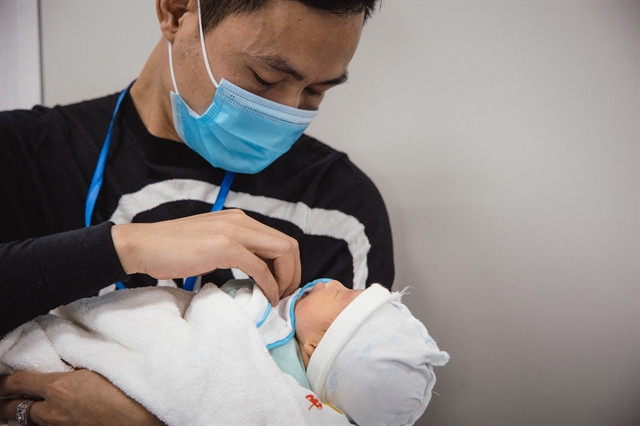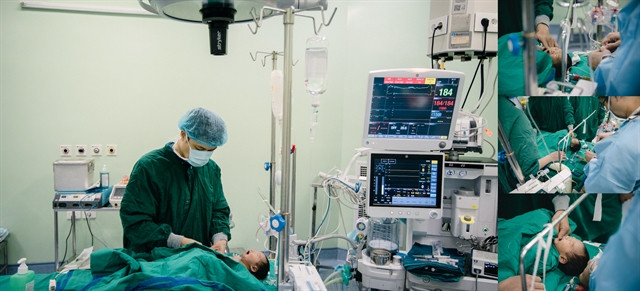Hanoi (VNA) - The hardest time in the lives of the young couple may never have ended if their infant child didn’t survive that afternoon.
At about 3pm one day on February 26, Do Van Luong, 35, from the northern province of Bac Giang, clung tightly to his four-day-old son for the final time before leaving him with the medical staff.
In just a few minutes, his son, Quoc Thien, would enter into a life and death struggle at the National Children’s Hospital (NCH).
He was ready for Transposition of the Great Arteries (TGA) surgery, one of the most complicated heart operations, especially for new-borns.
The infant had a heart deformity related to the arterial stem, a particularly dangerous condition for infants when not treated in time.
 Do Van Luong and his four-day-old son Quoc Thien just before the surgery. (Photo: Minh Son/Vietnamplus)
Do Van Luong and his four-day-old son Quoc Thien just before the surgery. (Photo: Minh Son/Vietnamplus)Dr Nguyen Ly Thinh Truong, director of the Heart Centre (CHC) at the NCH, and his colleagues carefully prepared for the surgery and were ready to do everything to save the little boy.
About a decade ago, TGA struck fear into the parents of new-borns diagnosed with the condition.
Now, though, at the CHC, the disease can be treated effectively thanks to talented surgeons, advancements in diagnosis and treatment, and, especially, the centre’s post-surgery care.
The father said that although he was upset and anxious, he felt relieved after being told that the operation would be conducted by a team headed by one of the leading doctors in children’s heart surgery.
He learned that Dr Truong is an expert in handling rare cases like his son.
Little Thien was diagnosed with TGA disease when he was still in his mother’s womb, and Luong had come down to Ha Noi from Bac Giang with his wife to the National Hospital of Obstetrics and Gynaecology.
His wife was yet to see their child, as he had been immediately taken to the NCH.
Although he had handled many such cases, this was only perhaps the second time he had seen such a condition.
“This case was especially difficult,” he said. “A deviation of only one-third or half a millimetre will affect his life, because the coronary artery’s job is to supply almost all of the heart’s blood.”
According to the doctor, the diameter of a coronary artery in a new-born is only about 1-1.5mm, which is not even visible to the naked eye, so doctors use a magnifying glass to perform the surgery. The permissible deviation is only about 0.2-0.5mm.
 A 10-member surgical team - including five doctors and five nurses - perform the surgery (Photo: Minh Son/Vietnamplus)
A 10-member surgical team - including five doctors and five nurses - perform the surgery (Photo: Minh Son/Vietnamplus)There are hundreds of patients needing TGA surgery as soon as possible, but Dr Truong said Thien’s case was difficult since the position of the coronary artery was abnormal.
Most babies in this condition undergo TGA surgery within their first month of life, but there are some who need it within two weeks.
“If the surgery is successful, the baby will go on to lead a normal life,” the doctor said.
However, he added, it was important to take special care of such children and attend periodic examinations, as patients with other congenital heart diseases must do. A few patients will need a second operation at some point in their lives.
TGA is a serious heart defect that occurs before birth. It causes a change in the blood circulation throughout the body, resulting in a lack of oxygen in the blood when it leaves the heart. The little patients may face severe complications or even death if not diagnosed and treated quickly.
“Arterial transfer disease may be found before birth or from the first hours to weeks after birth,” Dr Truong said, adding that this was the 581st TGA surgery performed at the NCH. “It is a complicated and serious congenital heart disease that often requires surgery in the first month after birth.”
“If not detected in time, 80-90 per cent of babies will die in the first year. And they cannot undergo surgery after they are two or three months old.”
The doctor has made a significant contribution to the success of the CHC in treating children’s heart conditions.
A complex operation such as TGA now takes four or five hours, whereas in the past it was anywhere between half a day or even more than a day.
Not only little Thien but also hundreds or even thousands of other new-borns suffering from congenital heart diseases will survive in the future, thanks to advancements in medicine and healthcare in Vietnam.
The TGA surgeries performed at the CHC affirm that the professionalism of Vietnamese doctors and medical staff is at least the equal of those in the region and the world, filling people with confidence that even the most severe condition can now be treated right here at home./.



























